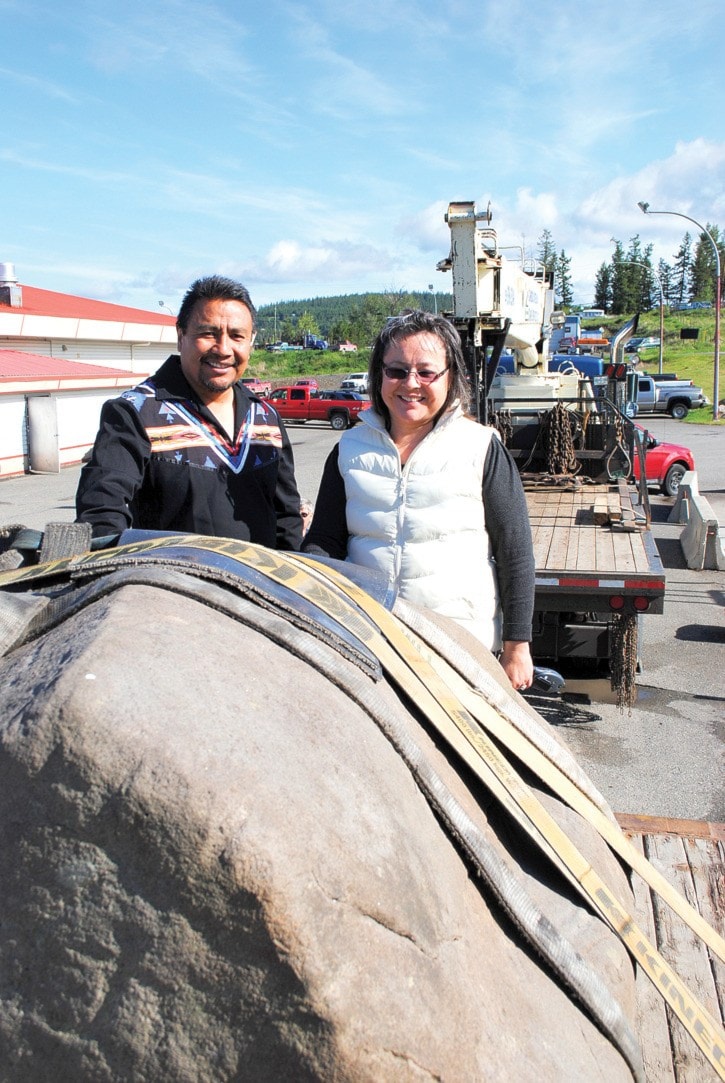A petroglyph that’s been in Vancouver since 1926 was being repatriated and permanently placed at the Churn Creek Protected Area Wednesday.
The 11,000-pound boulder was loaded onto a Caribou Interior Crane Services truck at the Vancouver Museum and brought up to the Cariboo.
The rock departed from 150 Mile House Wednesday. From there the convoy will travel via Sheep Creek/Farwell Canyon, through Gang Ranch, although not along the Gang Ranch bridge because it cannot support the weight of the rock.
The rock was to arrive at Churn Creek by noon, and from there a procession will begin at 2 p.m. for the last 1.5-kilometre journey to place the rock at the Churn Creek kiosk.
The journey home kicked off Monday with a ceremony at the Vancouver Museum. In attendance were staff from the museum, Stswecem’c Xgat’tem and Musqueam First Nations leaders, Vancouver mayor Gregor Robertson and Cariboo Regional District board chair Al Richmond.
In her speech at the ceremony, Phyllis Webstad focused on the time period of 1926 when the petroglyph was removed from the region and moved to Stanley Park in Vancouver, first using horses and then rail.
Webstad described it as a time when Stswecem’c Xgat’tem or Shuswap were the only languages spoken — English wasn’t understood.The only mode of transportation was horse and wagon. There weren’t any roads, only trails.
“My grandmother had just turned seven and was entering residential school for the first time in our history. We were put onto reserves and it was a time when we didn’t have a say about anything. We had to get passes to leave the reserves so basically anything could happen,” she said, adding today things have changed dramatically.
Richmond said after following the repatriation effort over the last two years, it was great to finally see the petroglyph in person.
“The fact that it was 1926 when it left and seeing the kind of condition it’s in was good. It’s been well preserved in the main inner courtyard at the Vancouver Museum where it’s been since 1992.”
Monday’s ceremony was well-attended, with about 70 people in attendance, Richmond said. “There was a wonderful blessing done by Stswecem’c Xga’tem First Nation (SXFN) member Gwen Therrian for the rock’s trip home. It’s good to see it coming home.”
The best part, he added, was to watch the elders who attended the ceremony.
“They were quite emotional about seeing it come home, and the spirit of the rock, as they see it, being called home to its ancestry. A good deal of the people that were there for speeches and lunch stayed to watch the ceremony afterwards.”
Describing the Vancouver Museum staff as having grown attached to the petroglyph over the years, Richmond said he could tell they were all very happy to be seeing it going home.
Wednesday morning Stswecem’c Xgat’tem chief Hank Adam was relieved the rain clouds had subsided and said it made a world of difference to see the sun.
“I’m anxious about the road down into Churn Creek that it may be really muddy, but I’m glad we have the rock on the truck. That took 11 hours,” he said, adding there was a big applause when they got it out of the courtyard and onto the truck in Vancouver.
Before departing from 150 Mile House, Adam said he was looking forward to laying the rock to rest.
